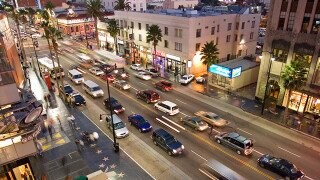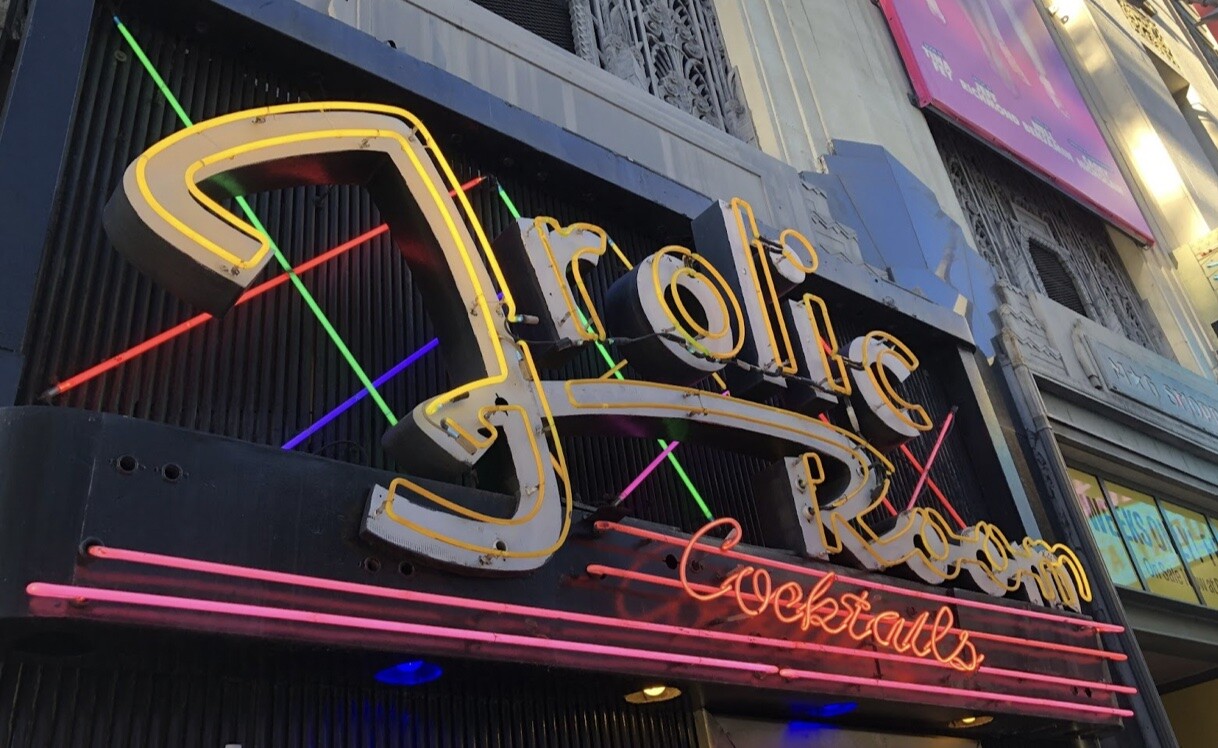Hollywood Boulevard Is Los Angeles's Own Personal Underworld

William Kuechenberg
Feeling refreshed by the sea air of Santa Monica, my wife and I decided to brave somewhere truly scary: Hollywood Boulevard, the Worst Place in Los Angeles. It’s a tacky, dirty tourist trap that reeks of a sickly yellow piss-fog. Brave, if you will, a new installment of TINSELTOWN TERRORS?!?
When people who don’t live in LA say they hate LA, they mean they went to Hollywood Boulevard and hated it. Which is kind of like saying you “hate New York” because you only went to Times Square and not the good reason to hate New York (the populace is mean, but not in a funny way, like Chicago). While I’m on the subject, here’s a little LA Secret… well, I’m not supposed to tell you this, but what the heck: when people who do live in LA say they hate LA, we’re actually just lying because we don’t want any more people to live here. LA is easily the best city in the country. Except for Hollywood Boulevard, which sucks ass.
The Approach
Which is also where we are today! The horror started off immediately when we had to pay thirty godforsaken dollars for parking in what is, let me remind you again, the worst part of the city. I once parked at a parking lot on the same block as this one to attend a film festival, and as I walked back to my car a man approached me and asked if I wanted to buy some crack. I could only muster the stock answer of “oh, not today, thank you,” like he was a waiter offering me a summer salad.
Don't Miss
After angrily shelling out thirty bucks for parking we made our way to the Pantages Theater, where the tour was starting. Unlike the Santa Monica tour, there was a small group with us this time. Our tour guide was a rather spry older gentleman named Paul, who was quite knowledgeable of both ghosts and the broader history of Los Angeles. He also looked almost exactly like Ron Paul, the favorite politician of people everywhere who see “legalize marijuana” listed first on a party platform and then stop reading.
Once the tour group was gathered up, he began to tell us a bit about the history of the Pantages Theater, which is a metaphor for the most frustrating thing about Hollywood Boulevard – there are a lot of really gorgeous, historical theaters, but they’re shoulder-to-shoulder with stores that sell nothing but CBD and t-shirts that say “I GOT MY DONG SLURPED ON HOLLYWOOD BOULEVARD… AND ALL I GOT WAS THIS LOUSY T-SHIRT, AND ALSO MY DONG SLURPED.”
Anyway, according to Paul, our tour guide, the Pantages Theater has somewhere in the neighborhood of seven ghosts; all new employees of the Pantages are trained on what ghosts live there. Pantages, the man for whom the theater is named, apparently hangs out there in death. He died angry that his theater was essentially bought out from under him by Joe Kennedy Sr. and William Randolph Hearst, News Bastard.
During a production of Joseph and the Technicolor Dreamcoat, the power went out and left a costume designer stranded in the dark labyrinth of costumes below the stage. She felt a gentle hand leading her back to the theater lobby and attributed it to the ghost of Pantages. Nice fella!
But the theater houses more than eponymous ghosts. It also houses the soul of former owner Howard Hughes, the blueprint of what would become a very common type of guy: guy who decided he’s too insane even for LA and so moves to Vegas instead. Hughes moved his personal offices to the theater, and Paul told us that his acquaintance named David, at one point the head of maintenance for the Pantages, saw Hughes’ ghost on two separate occasions in the rooms that used to house his office. No word on whether he was completely nude and pissing in a jar at the time, but if he’d fit right in here on Hollywood Boulevard!
Next we moved next door to the Frolic Room, conveniently next door to the Pantages.

William Kuechenberg
A famous Hollywood hangout for the better part of a century, it’s a storied bar and was a favorite hangout of celebrities and one of Bukowski’s favorite drinking spots – that and pretty much anywhere else in LA that had alcohol or sufficiently potable paint thinner. While Paul didn’t mention this, it’s also worth mentioning that, according to some theories, this was the very bar where Tom Waits was inspired to record Heartattack and Vine after a bartender callously threw out a unhoused woman who claimed she was having a heart attack. That act may have been unspeakably cruel, but on the other hand it got us like the thirteenth or fourteenth best Tom Waits studio album.
As I thought about how it seems like all my artistic icons are Los Angeles alcoholics and what that might mean for my future, Paul led us further down the Walk of Fame to our next location. And fine, I’ll admit it: I used this opportunity to exorcize the last remnant of my Midwestern-Tourist-in-Los-Angeles impulse by pointing at every name I recognized on the Walk of Fame and hooting. Remember, if your publicist coughs up $55,000, you too can get your name there.
The Descent
We rounded a corner and came face-to-face with the Hollywood Knickerbocker Hotel, an old-school Los Angeles landmark. Built in 1929, it’s been a significant part of film industry history. Elvis stayed here while making Love Me Tender. Marilyn Monroe and Joe DiMaggio would meet here for trysts. The legendary costume designer Irene Lentz committed suicide here. And, of course, D.W. Griffith might've died here while walking underneath the lobby’s chandelier (but also might've died in his room).
If you don’t know who D.W. Griffith is, he made Birth of Nation, which is widely considered to be the first modern film. There’s no delicate way to say this, so I’ll just come right out: it’s also about how the Ku Klux Klan is the only thing that can save America from Black people. The specter of Griffith can still occasionally be seen in the hotel, presumably because he wants to take a break from Racism Hell. (Maybe he’d be more comfortable haunting Calico?)
Besides him, William Frawley, who played the landlord on I Love Lucy, also died after walking under the chandelier, also of non-chandelier-related causes. The roof of the Knickerbocker was also the site of the tenth and final annual attempt to summon the ghost of Harry Houdini in a séance on Halloween, 1936 – if you don’t know the story, Houdini was hugely skeptical of séances and mediums, and told his wife Bess a secret code he’d use to communicate with her after he died. After this séance failed (although, according to legend, an unexpected and sudden thunderstorm did occur as it was happening), Bess is said to have symbolically extinguished a candle which she’d kept burning for ten years, officially ending her search to communicate with her dead husband.
We stopped next where we had a view of the Hollywood sign through an empty lot, because everybody loves stark symbolism.

William Kuechenberg
Our next stop was the Hollywood Pacific Theater, formerly known as the Warner Theater. This was exciting for me as a cinéaste (French for “big weird nerd who likes movies to a frankly upsetting degree”), as the Warner Theater is a significant piece of film history. Also it’s haunted or something, the electrical system goes haywire unless you audibly ask the ghosts to stop, shadowy figures are seen in the lobby, elevators move by themselves, blah blah blah, whatever. That’s not what’s interesting to me. What’s interesting to me is that in 1927 Sam Warner, of the Warner Brothers, spent a fortune building this gigantic theater that seats nearly 3,000 people and had it specially built to show the Film of the Future: talkies!
So Sam Warner desperately wanted The Jazz Singer, the first feature length film with synchronous dialogue and music, to premiere at the Warner theater. But it seemed like construction wasn’t going to be done in time, and so, fearful that competing studios would beat them to the punch on talkies, the other Warners decided to go ahead and hold the premiere at a theater in New York. Sam was furious that they wouldn’t delay the film to let it premiere at his theater in their home turf of Los Angeles, and so, in an act of spite so legendary that Catholic mothers everywhere whisper about it in awed tones, just to get the last laugh Sam up and died the day before The Jazz Singer premiered in New York. This forced the other Warner siblings to spend the premiere in Los Angeles, anyway, for his funeral. Yakko, Wakko, and Dot were said to be inconsolable.
Sam’s ghost still hangs around the now defunct theater, but that’s a lot less interesting/hilarious to me than literally dying just to spite your own family. Now the Pacific Theater, a major part of Hollywood history, is a crumbling, abandoned ruin, its majestic edifices just homes for diseased pigeons and particularly adventuresome rats. And it squats in Hollywood Boulevard in a sea of filth and the absolute worst mass-produced touristy crap imaginable. (One more quick note: The Jazz Singer is about a jazz singer who performs in blackface. Between that and Birth of a Nation, why must every film that irrevocably changes the medium also have to be super-racist?)
We passed a few more interesting things, such as the Egyptian Theater, the bar where the Black Dahlia was last seen alive, and Marilyn Monroe’s star on the Walk of Fame, which was directly outside of a McDonald’s, which really sums up LA in a nutshell. With our trip winding down to a close, we came to the famous Roosevelt Hotel:
Our excellent tour guide Paul had a lot of great stories about the Roosevelt, such as how a faceless man in a tuxedo can sometimes be seen wandering the Blossom Room – perhaps an actor dissatisfied with his legacy? After all, the very first Academy Awards Ceremony was held there. Marilyn Monroe lived there for two years, and the mirrors in her room were then distributed throughout the hotel. It’s been reported by multiple people working there that, late at night, they can sometimes catch a glimpse of a blonde woman sobbing into her hands behind them when they look into the mirrors that belonged to her. Which honestly freaked me out a bit – there’s something inherently freaky about mirrors, and not just for Candyman-related reasons.
We ended our tour at the Dolby Theater, current home of the Academy Awards ceremony. The Dolby Theater, by the way, is also a shopping mall, so while you’re picking up your Oscar you can also grab some bath bombs real quick.
Score on the Spookometer: Hollywood Boulevard might be the only place in Los Angeles to see Spider-Man Wearing a Fanny Pack loudly arguing in Russian with Fat Darth Vader, a man selling live turtles on the street, and everyone’s favorite legally distinct horror movie icons (Poundfoolish the Sewer Clown, Frederick the Knife Glove-Haver, and Literally Just a Guy Holding a Snake) that you can take selfies with for money.
William Kuechenberg is a repped screenwriter, a Nicholl Top 50 Finalist, and an award-winning filmmaker. He’s currently looking to be a writer’s assistant, a showrunner’s assistant, or even to be staffed on a television show: tell your friends, and if you don’t have any friends, tell your enemies! You can also view his mind-diarrhea on Twitter.